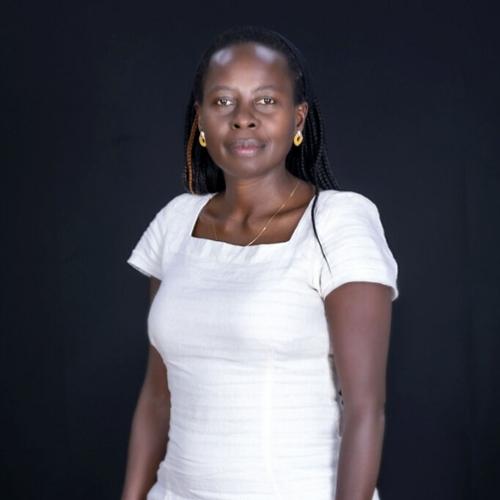KeyWay Report on Our Speaker, Nov. 14, 2025
Ms. Margaret Nagawa, PhD candidate at Emory University and instructor at Spelman College
AWER Program at Georgia Tech | November 14, 2025

Rose Caplan gave an excellent welcome to Ms. Margaret Nagawa, PhD candidate at Emory University and instructor at Spelman College, to share insights from her curated exhibition “Insistent Presence: Contemporary African Art from the Chazen Collection” at the Carlos Museum of Art.
Her presentation invited members to see contemporary African art as a site of memory, identity, and social commentary, with particular attention to how artists make the human body present or absent in their work. Drawing on her experience as an artist, curator, and emerging art historian, Nagawa explained that her career has moved through studio practice, gallery work, university museums, and now doctoral research. She has curated exhibitions at institutions such as Makerere University and the Chazen Museum of Art, completed curatorial training at Goldsmiths College, University of London, and currently teaches at Spelman College while advancing her PhD at Emory. This blend of practice, curatorship, and scholarship positions her to navigate the spaces where art is created, interpreted, and shared with public audiences.
Margaret Nagawa described how the “Insistent Presence ...” exhibition, which took a year to assemble, began with an invitation in 2022 to work with the Chazen’s contemporary African art collection, originally assembled as a teaching resource for African Studies courses. Over the course of a year, from initial conversations in June and a contract in August 2022 through the opening in August 2023, she studied the collection and identified a recurring concern with the human figure. Drawing on art historian Chika Okeke-Agulu’s observation about the persistent human figure in contemporary African art, Ms. Chika shaped the exhibition around the tension between presence and absence of the human figure. The show is structured in three parts, “The Absent Body,” “The Body in Society,” and “The Artist Is Present,” each asking how artists use the figure, or its removal, to speak about history, politics, trauma, and everyday life.
Several artists and works brought these themes into focus. Ethiopian artist Dawit Abe uses elongated, burdened male figures to explore labor and inequality, setting them in visual tension with images of figures like the Queen of England to highlight power imbalances and unseen labor. Senegalese photographer Malik Welli stages scenes such as “Sisters Cluny, Saint-Louis,” which appears to depict Catholic nuns but in fact shows models in costumes he designed. By carefully constructing the image, he invites viewers to question assumptions about authenticity and representation.
AWER Members also heard about the educational and professional journey that prepared Nagawa for this work. She studied painting and sculpture at the Margaret Trowell School of Art at Makerere University, worked as an artist, then joined a commercial gallery to support her practice. Her desire to understand how artworks move into public life led her to formal training in art curatorship at Goldsmiths and work in London’s museum district before returning to Makerere. Later, she returned to graduate study at Emory to deepen the connections between contemporary African art and historical African forms, supported by an advisor who helps her bridge practice and research. During the program, a visiting Maynard Jackson High School junior, Kaylah Rhaney, asked how curating “Insistent Presence” shaped Nagawa personally. Nagawa shared that she stepped away from her PhD timeline to take on the project, and that it pushed her into new territory, particularly Francophone West Africa, where she worked through language barriers with the help of translators and student collaborators. Plus, it made her realize she needed to become more skilled in French. Her advice highlighted the value of learning another language as a way to open doors, expand thinking, and build friendships across borders.
Throughout the meeting, the club’s regular business and a brief DEI moment framed the program in the context of Rotary’s commitments to inclusion, cultural understanding, and peacebuilding. Nagawa’s emphasis on artists who engage social inequality, historical memory, and contested identities aligned naturally with Rotary’s focus on promoting peace, supporting education, and advancing community development. Her stories about navigating linguistic and regional divides mirrored Rotary’s work in building bridges between communities, and her engagement with students and university galleries resonated with AWER’s support for youth and lifelong learning. And, she also expresses the need not to allow society to limit our own visions to the world around
The program closed with clear invitations for further engagement. Members were encouraged to visit the “Insistent Presence” exhibition at the Carlos Museum before it closes on December 14.
--- Neil Shorthouse, Keyway Speaker Reporter
November 20, 2025
Comments
This Year’s Posts:
- Nov 30: "Discovery Rotary" - An Event for Prospective Rotarians Only
- Nov 5: Join Atlanta Metro's Pickleball for Polio Tournament
- Sep 29: Club of Excellence Awards 2024-2025
- Sep 21: Still Time to Create a Plan for World Polio Day – October 24!
- Aug 25: Get Ready for World Polio Day – October 24!
- Jul 3: Let's Grow Rotary Together: Don’t Miss the D6900 Membership Summit 1
- Jul 2: Let's Go Back to RYLA 2025! 1